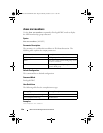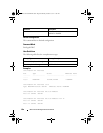
626 Port Channel Commands
The hashing algorithm is configurable for each LAG. Typically, an
administrator is able to choose from hash algorithms utilizing the following
attributes of a packet to determine the outgoing port:
• Source MAC, VLAN, EtherType, and incoming port associated with the
packet.
• Source IP and Source TCP/UDP fields of the packet.
• Destination MAC, VLAN, EtherType, and incoming port associated with
the packet.
• Source MAC, Destination MAC, VLAN, EtherType, and incoming port
associated with the packet.
• Destination IP and Destination TCP/UDP Port fields of the packet.
• Source/Destination MAC, VLAN, EtherType, and incoming port
associated with the packet.
• Source/Destination IP and source/destination TCP/UDP Port fields of the
packet.
Enhanced LAG Hashing
PowerConnect devices based on Broadcom XGS-IV silicon support
configuration of hashing algorithms for each LAG interface. The hashing
algorithm is used to distribute traffic load among the physical ports of the
LAG while preserving the per-flow packet order.
One limitation with earlier LAG hashing techniques is that the packet
attributes were fixed for all type of packets. Also, there was no MODULO-N
operation involved, which can result in poor load balancing performance.
As part of Release 4.0, the LAG hashing support is extended to support an
Enhanced hashing mode, which has the following advantages:
• MODULO-N operation based on the number of ports in the LAG.
• Packet attributes selection based on the packet type. For L2 packets,
Source and Destination MAC address are used for hash computation. For
IP packets, Source IP, Destination IP address, TCP/UDP ports are used.
• Non-Unicast traffic and Unicast traffic is hashed using a common hash
algorithm.
• Excellent load balancing performance.
2CSPC4.XCT-SWUM2XX1.book Page 626 Monday, October 3, 2011 11:05 AM


















